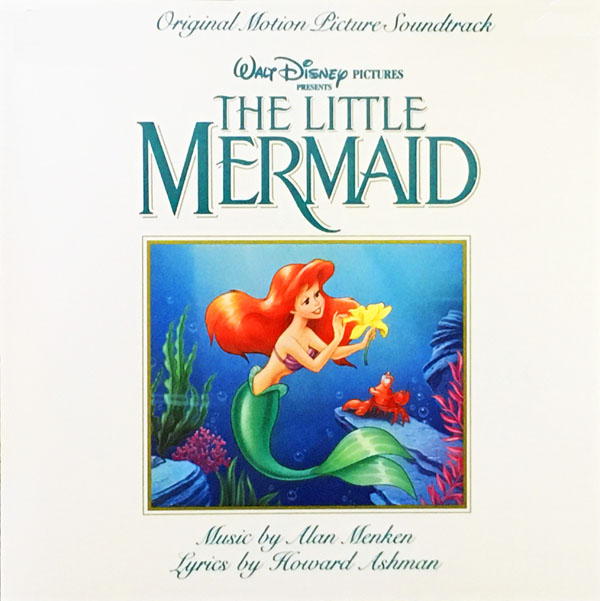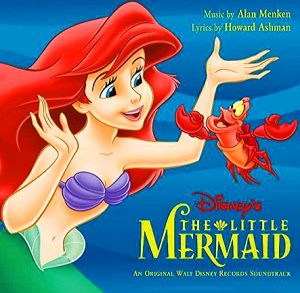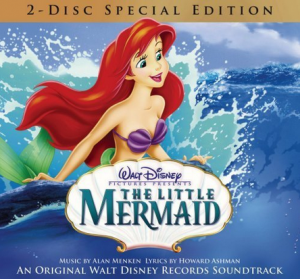Thirty years ago this month, Disney returned to its musical fairy tale roots (with a contemporary edge) and scaled heights far beyond some expectations. But we knew.

Walt Disney Pictures Presents
THE LITTLE MERMAID
Original Motion Picture Soundtrack
Walt Disney Records CD-018 (Compact Disc)
CD Reissues: #60946-7 (1997); #61618-7 (Special Edition, 2006); D-0020656692 (Legacy Collection, 2014) –
Vinyl Reissues: D001988501 (Picture Disc, 2014); D-003102001 (Vinyl Vault, 2019)
Released in 1989. Produced by Howard Ashman, Alan Menken, Robert Kraft. Arrangements: Robbie Merkin, Alan Menken. Orchestrations: Thomas Pasatieri. Conductor: J.A.C. Redford. Running Time: 43 minutes.
Voices: Jodi Benson (Ariel); Pat Carroll (Ursula); Samuel E, Wright (Sebastian); René Auberjonois (Chef Louis).
Songs: “Fathoms Below,” “Daughters of Triton,” “Part of Your World,” “Under the Sea,” “Poor, Unfortunate Souls,” “Les Poissons,” “Kiss the Girl” by Howard Ashman, Alan Menken.
Much has been written about the “second golden age” of Disney animation and how it was ushered in by the largely unexpected success of The Little Mermaid, the first Disney animated musical fairy tale feature since 1959’s Sleeping Beauty. (Oliver and Company played no small part in that renaissance as well, but that’s another Spin to come.)Instrumentals: “Main Titles,” “Fanfare,” “Fireworks,” “Jig,” “The Storm,” “Destruction Of The Grotto,” “Flotsam And Jetsam,” “Tour Of The Kingdom,” “Bedtime,” “Wedding Announcement,” “Eric To The Rescue,” “Happy Ending” by Alan Menken.
The Little Mermaid was a game-changer in numerous ways. It was a wake-up call to the Walt Disney Studios to re-embrace the kind of stories that resounded with all ages and to produce the kind of music that went on playing forever. While it might have seemed unlikely at first that this revelation should come from the musical team behind the Off-Broadway musical hit Little Shop of Horrors, the combination of Menken’s mastery of melody (both in song and background music) and Ashman’s astonishing grasp of Disney musical storytelling was lightning in a bottle.
It is a serious mistake to think of Ashman’s role as lyricist alone. He was the lynchpin of Little Mermaid’s musical core, as well as that of Beauty and the Beast and Aladdin (and arguably to many that came after his untimely passing). Offered a creative role with Disney, he surprised some by turning down much higher profile live-action features to concentrate on animation, which he believed was the best—and perhaps the last—cinematic horizon for musical storytelling.
Shortly after he and Menken joined the staff, he prepared a talk about the importance of music and animation. To many, what he said might seem obvious, yet it is a lesson that must be relearned just as any history continues to repeat itself. The DVD release of the superb documentary feature Waking Sleeping Beauty included this bonus feature about Ashman called “The Poet.”
The Disney soundtrack album itself was also changed by The Little Mermaid. Starting in 1956, when Disneyland Records began releasing soundtrack albums of live-action and animated titles on vinyl, the track format alternated between songs and instrumentals. The tracks were not necessarily in the chronological order of the way they played out in the finished film. Most soundtracks and Broadway cast albums followed this format, more or less, throughout the mid-20th century.
The Little Mermaid album follows, with some variance, what might be described as a pop musical soundtrack format. Perhaps the most famous example is Yellow Submarine, which contains all The Beatles songs on side one and George Martin’s underscore on side two.
In the late 1970s, pop soundtracks like Grease and Xanadu separated tracks on opposing sides of each disc. One side could contain all the hits by the headline stars, another side with background songs by studio artists, or one side for each artist. Suddenly a LP could be more like 45 RPM singles, with an “A” side or “plug” side and a “B” side.
The Little Mermaid album was designed so that every major song played on side one. There were a few brief instrumentals including, such as the Main Title, but all the other incidental music was pushed to side two, which in effect started the movie all over again and finished with the finale. In effect, this format presents the film soundtrack twice from two viewpoints.
On the plus side, some impatient kids may love the idea of playing just the songs without all those “boring” instrumentals slowing down the fun. Hopefully children do indeed include side two at least occasionally, otherwise they would miss out on the musical richness of wondrous background music. To those who are familiar with the early Disneyland albums, imagine taking the Pinocchio “DQ” album, for instance, with all the vocals on side one and all the underscore side two. Not only would it have changed the musical experience, but it makes one wonder if side two might have been left in the dust more often than not. But that’s just conjecture—who knows how everyone has listened and will listen in the future? The Mermaid soundtrack album was a smashing success, and its format has become the standard of every Disney animated musical feature soundtrack album to date, as well as live-action musicals such as Mary Poppins Returns (and you can always rearrange CD and download tracks in any order you please).
Disneyland Records changed its name to Walt Disney Records not too long before The Little Mermaid album was released. Vinyl was considered dead (To quote Chef Louis, “Hee-hee-hee, haw-haw-haw!”) making Mermaid the first Disney animated soundtrack available only on cassette and compact disc for many years (your author purchased his first CD player specifically for this album). According to Walt Disney Records Producer Randy Thornton, a 1989 vinyl record was planned with the same cover design as the CD, but it was abandoned (no vinyl version was available in the U.S. until the 2014 picture disc). This year, the Disney Music Emporium has made it available exclusively, plus Walt Disney Records Netherlands produced an identical vinyl version, but with a different cover design.

Adding in the picture disc (above), that makes three vinyl versions of The Little Mermaid available during its anniversary year (as well as downloads and CDs).
“Poor Unfortunate Souls” Demo – Howard Ashman
The video above shows the detailed direction Ashman offered for the performance of the songs. This demo shows how much he had in his head before it even reached the rehearsal stage with the great Pat Carroll, who ultimately voiced Ursula.




 GREG EHRBAR is a freelance writer/producer for television, advertising, books, theme parks and stage. Greg has worked on content for such studios as Disney, Warner and Universal, with some of Hollywood’s biggest stars. His numerous books include Mouse Tracks: The Story of Walt Disney Records (with Tim Hollis). Visit
GREG EHRBAR is a freelance writer/producer for television, advertising, books, theme parks and stage. Greg has worked on content for such studios as Disney, Warner and Universal, with some of Hollywood’s biggest stars. His numerous books include Mouse Tracks: The Story of Walt Disney Records (with Tim Hollis). Visit 





















































One other aspect of “The Little Mermaid” was a return to the cleaner line drawings of the 30’s through the late 50’s, which had not been seen since the release of “Sleeping Beauty”. Every Disney animated feature and short subject had used the Xerox method from “One Hundred and One Dalmatians” on, all the way through “Oliver and Company.” The Xerox method used dark, sketchy outlines that rendered the characters in a loose, exaggerated style that became the generic Disney “look” for decades. Contrast the 1977 film “The Rescuers” with its 1991 sequel “The Rescuers Down Under” (which was the next Disney feature after “The Little Mermaid” and utilized the same style of cleaner line drawings) and the difference is readily apparent. So not only was the “Disney Renaissance” a return to rich musical scores that could readily compete with anything on Broadway, it was also a return to a classic style of animation that had not been utilized for a couple of generations.
When a new Xerox feature was released, my brother and I would say, “Oh no, not the scritchy lines again!”
Disney was already using clean lines by The Small One in 1978, though it’s safe to say that Little Mermaid had the cleanest lines yet. The influx of young artists in the mid ’70s meant better clean-up work in the following decade. Incidentally, Mermaid was the last Disney feature to use painted cels and optical camera work; starting with Rescuers Down Under, they used their proprietary CAPS software to digitally color the drawings and composite the artwork, which they would continue to use until the switch to CGI. (The Princess and the Frog and Winnie the Pooh used Toon Boom Harmony.)
Has it really been thirty years? I’ll never forget when my parents took me to see “The Little Mermaid” on my birthday during its initial release. (I was 29, and it was one of my best birthdays ever.) I enjoyed it much more than they did; as Hans Christian Andersen purists, they were disappointed that Ariel didn’t die in the end.
I want to say a few words about Thomas Pasatieri, who orchestrated the musical score to “The Little Mermaid”. A child prodigy, he enrolled in New York’s Juilliard School at 16 and became the first person to receive a doctorate in composition from that institution. He has orchestrated dozens of film scores, including animated Disney features like “Finding Nemo” and “Wall-E” and also live-action films such as “The Shawshank Redemption”, “Erin Brockovich” and “American Beauty”. But this is only a sideline to his musical career. Pasatieri is a renowned composer of opera, having written two dozen of them; I remember seeing his opera “The Trial of Mary Lincoln” broadcast on PBS in the seventies. He has also composed a large body of vocal music as well as instrumental works, including three symphonies.
Film scores are often orchestrated by teams of apprentices working under imminent deadlines; the result may justly be described as hackwork. For a musical film to be orchestrated by a distinguished operatic composer in his own right is practically unheard of. This level of artistry, in every aspect of production, is what it takes to create a masterpiece like “The Little Mermaid”.
Thanks for acknowledging and detailing one of the many unsung heroes of what makes such music great, Paul. Alan Menken has been very gracious in his acceptance speeches to mention Pasatieri and his other collaborators when receiving his honors, which is very classy (and increasingly rare in a society that seems commensurate with increasing award ceremonies and self-aggrandizement). If there is one thing above all that Animation Spin — and Mouse Tracks — has as a mission, it’s to make sure those in the background get into the foreground..
And just think, in another decade or so, most of the artists responsible for this renaissance (a mere five years earlier, Disney was fighting off a hostile takeover; and the failure of “The Black Cauldron” didn’t help things much) would be thrown out without so much as a severance package because CGI had taken over. Yet so much of what Disney has achieved in the meantime–the live action remakes, the Broadway musicals, the direct-to-video sequels–stems directly from that golden era ushered in by “Little Mermaid” (and which died with junk like “Treasure Planet” and “Home On the Range,” which, let’s face it, wouldn’t have been any good in CGI, either).
Was that Debbie Downer comment really necessary(and I though “Treasure Planet” was good…)? Besides, I thought the two traditional animation film that came out in the last 10 years (“The Princess and the Frog” and “Winnie the Pooh”) were well-done and hopefully Jennifer can convinced the company to do another traditional animated film (I hope).
This is actually to Nic Ramer:
Nick, how about the big Amy Adams hit. “Enchanted?”
Actually, the animation for “Enchanted” was done by an outside studio run by a former Disney animator.
In my opinion, even though it’s not part of the Disney animated film canon, I see “Who Framed Roger Rabbit” as the start of Disney’s Silver Age (a.k.a. Disney Renaissance) rather than “The Little Mermaid” (I do love “The Little Mermaid” and I see it as the start of the animated Broadway musical genre however). Here’s my views of the Walt Disney Animation Studios feature film canon eras (this is just my opinion of course):
Golden Age I (1937-1942): From “Snow White and the Seven Dwarfs” to “Bambi”
Package Film era (1942-1949): From “Saludos Amigos” to “The Adventures of Ichabod and Mr. Toad”
Golden Age II (1950-1977): From “Cinderella” to “The Many Adventures of Winnie the Pooh”
Dark Age I (1977-1986): From “The Rescuers” to “The Great Mouse Detective”
Silver Age (a.k.a. Disney Renaissance) (1988-1999): From “Oliver & Company” to “Tarzan”
Dark Age II (1999-2007): From “Fantasia 2000” to “Meet the Robinsons”
Bronze Age (a.k.a. Disney Revival) (2008-present): From “Bolt” to “Ralph Breaks the Internet”
I agree with you about the importance of “Who Framed Roger Rabbit”, which also inaugurated the Spielberg/Warner Bros. collaboration that gave us some of the best cartoons of the nineties. Your chronology is also pretty sound; however, you need to draw a big thick line of demarcation between “Sleeping Beauty” in 1959 and what came after. By no stretch of the imagination can “The Sword in the Stone” and “Robin Hood” be considered as part of any Disney “Golden Age!”